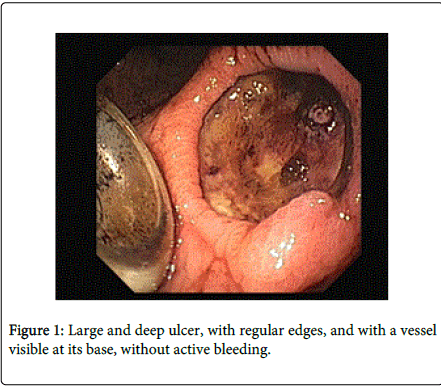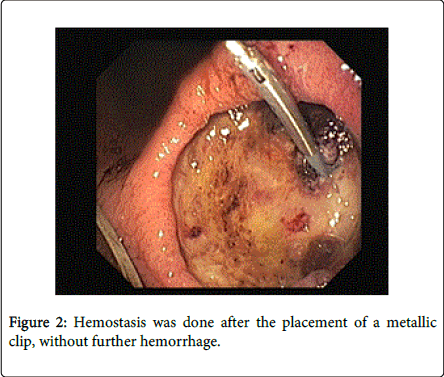Case Report Open Access
Kissing Gastric Ulcer: An Unexpected Complication of Percutaneous Endoscopic Gastrostomy
Armando Peixoto*, Regina Gonçalves and Guilherme MacedoGastroenterology Department, Faculty of Medicine, Centro Hospitalar de São João, University of Porto. Porto, Portugal
- *Corresponding Author:
- Armando Peixoto
Gastroenterology Department, Faculty of Medicine
Centro Hospitalar de São João
University of Porto. Porto, Portugal
Tel: +351910562169
E-mail: armandoafp5@gmail.com
Received date: June 24, 2015; Accepted date: July 21, 2015; Published date: July 27, 2015
Citation: Peixoto A, Regina Gonçalves and Guilherme Macedo, (2015) Kissing Gastric Ulcer: An Unexpected Complication of Percutaneous Endoscopic Gastrostomy. J Gastrointest Dig Syst 5:311. doi:10.4172/2161-069X.1000311
Copyright: © 2015 Peixoto A, et al. This is an open-access article distributed under the terms of the Creative Commons Attribution License; which permits unrestricted use; distribution; and reproduction in any medium; provided the original author and source are credited.
Visit for more related articles at Journal of Gastrointestinal & Digestive System
Keywords
Kissing ulcer; Percutaneous endoscopic gastrostomy; Gastric ulcer
Case Report
The authors report the case of a 76 years-old woman with that was brought to the emergency department with melena. She had amyotrophic lateral sclerosis and three months earlier an endoscopic percutaneous gastrostomy (PEG) was placed for severe dysphagia, with good functioning until that day. The patient presented with hypotension and tachycardia and severe anemia. After hemodynamic resuscitation an upper endoscopy was performed, in which it was observed the presence of fresh blood in gastric lumen and, entering the distal anterior gastric wall, the PEG’s internal bumper pressuring the lesser curvature of the distal gastric body, as if it was crimped in gastric wall. After air insufflation, underling the internal bumper after its displacement, it was found a large and deep ulcer, with regular edges, and with a vessel visible at its base, without active bleeding (Figure 1). Hemostasis was done after the placement of a metallic clip, without further hemorrhage (Figure 2). An elective removal of the PEG was scheduled, but the patient died on the following day by cardiorespiratory complications.
Although generally considered to be a safe procedure, there is the potential for both minor and major complications after PEG placement. However, in some instances, the diagnosis is challenging since candidates for PEG tube nutrition do not always communicate easily due to their underlying altered mental status. Patients may develop ulcers related to the PEG, either underneath the internal bolster or on the gastric wall. While this typically is seen in patients with longstanding PEG, it can be seen in patients with recently placed PEG, particularly if the external bumper is set such that the internal bumper is pulled tightly against the gastric wall. The ulceration of contralateral wall is a rarely described phenomenon, and this is the first recorded case of a “kissing ulcer” in this context.
--Relevant Topics
- Constipation
- Digestive Enzymes
- Endoscopy
- Epigastric Pain
- Gall Bladder
- Gastric Cancer
- Gastrointestinal Bleeding
- Gastrointestinal Hormones
- Gastrointestinal Infections
- Gastrointestinal Inflammation
- Gastrointestinal Pathology
- Gastrointestinal Pharmacology
- Gastrointestinal Radiology
- Gastrointestinal Surgery
- Gastrointestinal Tuberculosis
- GIST Sarcoma
- Intestinal Blockage
- Pancreas
- Salivary Glands
- Stomach Bloating
- Stomach Cramps
- Stomach Disorders
- Stomach Ulcer
Recommended Journals
Article Tools
Article Usage
- Total views: 15651
- [From(publication date):
August-2015 - Apr 03, 2025] - Breakdown by view type
- HTML page views : 11084
- PDF downloads : 4567


